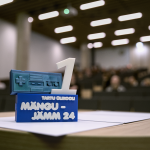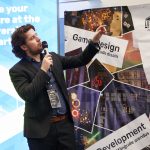Here are the tables of contents of some of the GPU Pro and GPU Zen books we have in our lab. You can use Ctrl+F to find keywords you are interested in from the article titles. For more info, you can check out the official GPU Pro and GPU Zen pages.
GPU Pro (2010)
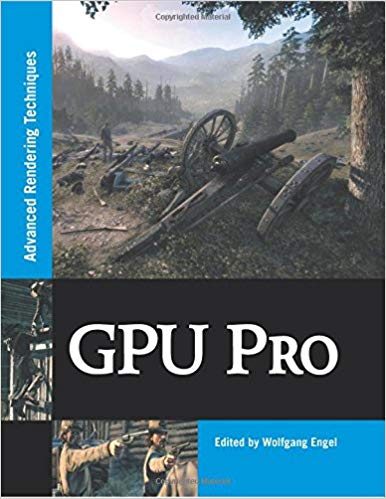
- Mathematics
- GPU Color quantization by Chi Sing Leung, Tze-Yui Ho and Yi Xiao
- Visualize Your Shadow Map Techniques by Fan Zhang, Chong Zhao and Adrian Egli
- Geometry Manipulation
- As-Simple-As Possible Tessellation for Interactive Applications by Tamy Boubekeur
- Rule-based Geometry Synthesis in Real-time by Milan Magdics and Gergely Klar
- GPU-based NURBS Geometry Evaluation and Rendering by Graham Hemingway
- Polygonal-Functional Hybrids for Computer Animation and Games by D. Kravtsov, O. Fryazinov, V. Adzhiev, A. Pasko, P. Comninos
- Rendering Techniques
- Quad-tree Displacement Mapping with Height Blending by Michał Drobot
- NPR effects using the Geometry Shader by Pedro Hermosilla and Pere-Pau Vazquez
- Alpha Blending as a Post-Process by Benjamin Hathaway
- Virtual Texture Mapping 101 by Matthaus G. Chajdas, Christian Eisenacher, Marc Stamminger, Sylvain Lefebvre
- Volume Decals by Emil Persson
- Global Illumination
- Fast, Stencil-Based Multiresolution Splatting for Indirect Illumination by Chris Wyman, Greg Nichols and Jeremy Shopf
- Screen-Space Directional Occlusion by Thorsten Grosch and Tobias Ritschel
- Real-time multi-bounce ray-tracing with geometry impostors by Peter Dancsik and Laszlo Szecsi
- Image Space
- Anisotropic Kuwahara Filtering on the GPU by Jan Eric Kyprianidis, Henry Kang and Jürgen Döllner
- Edge Anti-aliasing by Post-Processing by Hugh Malan
- Environment Mapping with Floyd-Steinberg Halftoning by Laszlo Szirmay-Kalos, Laszlo Szecsi, and Anton Penzov
- Hierarchical Item Buffers for Granular Occlusion Culling by Thomas Engelhardt and Carsten Dachsbacher
- Realistic Depth-of-Field in Post-Production by David Illes and Peter Horvath
- Real-Time Screen Space Cloud Lighting by Kaori Kubota
- Screen-Space Subsurface Scattering by Jorge Jimenez and Diego Gutierrez
- Handheld Devices
- Migration to OpenGL ES 2.0 by Ken Catterall
- Touchscreen-based user interaction by Andrea Bizzotto
- iPhone 3GS Graphics Development and Optimization Strategies by Andrew Senior
- Optimizing a 3D UI Engine for Mobile Devices by Hyunwoo Ki
- Shadows
- Fast Conventional Shadow Filtering by Holger Gruen
- Hybrid Min-MaxPlane-Based by Holger Gruen
- Shadow Mapping for Omni-Directional Light Using Tetrahedron Mapping by Hung-Chien Liao
- Screen Space Soft Shadows by Jesus Gumbau, Miguel Chover and Mateu Sbert
- 3D Engine Design
- Multi-Fragment Effects on the GPU using Bucket Sort by Meng-Cheng Huang, Fang Liu, Xue-Hui Liu and En-Hua Wu
- Parallelized Light Pre-Pass Rendering with the Cell Broadband Engine™ by Steven Tovey and Stephen McAuley
- Porting code between Direct3D9 and OpenGL 2.0 by Wojciech Sterna
- Practical Thread Rendering for DirectX 9 by David Pangerl
- Game Postmortems
- Stylized Rendering in Spore by Shalin Shodhan and Andrew Willmott
- Rendering Techniques in Call of Juarez: Bound in Blood by Paweł Rohleder and Maciej Jamrozik
- Making it large, beautiful, fast and consistent – Lessons learned developing Just Cause 2 by Emil Persson
- Destructible Volumetric Terrain by Marek Rosa
- Beyond Pixels & Triangles
- Parallelized Implementation of Universal Visual Computer by Tze-Yui Ho, Ping-Man Lam and Chi-Sing Leung
- Accelerating Virtual Texturing using CUDA by Charles-Frederik Hollemeersch, Bart Pieters, Peter Lambert, and Rik Van de Walle
- Efficient Rendering of Highly Detailed Volumetric Scenes With GigaVoxels by Cyril Crassin, Fabrice Neyret, Miguel Sainz, and Elmar Eisemann
- Spatial Binning on the GPU by Christopher Oat, Joshua Barczak and Jeremy Shopf
- Real-Time Interaction between Particles and Dynamic Mesh on GPU by Vlad Alexandrov
GPU Pro 2 (2011)
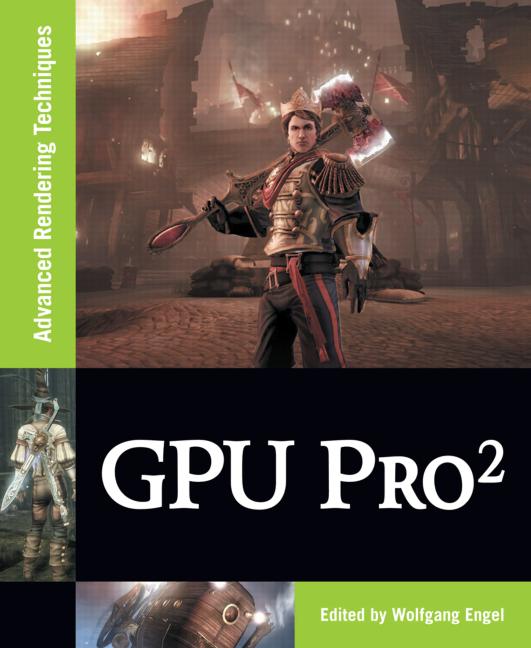
- Geometry Manipulation
- Terrain and Ocean Rendering with Hardware Tesselation by Xavier Bonaventura
- Practical and Realistic Facial Wrinkles Animation by Jorge Jimenez, Jose I. Echevarria, Christopher Oat and Diego Gutierrez
- Procedural Content Generation on GPU by Aleksander Netzel and Pawel Rohleder
- Rendering Techniques
- Pre-Integrated Skin Shading by Eric Penner and George Borshukov
- Implementing Fur in Deferred Shading by Donald Revie
- Large-scale terrain rendering for outdoor games by Ferenc Pintér
- Practical Morphological Anti-Aliasing by Jorge Jimenez, Belen Masia, Jose I. Echevarria, Fernando Navarro and Diego Gutierrez
- Volume Decals by Emil Persson
- Global Illumination
- Temporal Screen-Space Ambient Occlusion by Oliver Mattausch, Daniel Scherzer and Michael Wimmer
- Level-of-Detail and Streaming Optimized Irradiance Normal Mapping by Ralf Habel, Anders Nilsson and Michael Wimmer
- Real-Time One-bounce Indirect Illumination and Indirect Shadows using Ray-Tracing by Holger Gruen
- Real-Time Approximation of Light Transport in Translucent Homogenous Media by Colin Barré-Brisebois and Marc Bouchard
- Real-time diffuse Global Illumination with Temporally Coherent Light Propagation Volumes by Anton Kaplanyan, Wolfgang Engel and Carsten Dachsbacher
- Shadows
- Variance Shadow Maps Light-Bleeding Reduction Tricks by Wojciech Sterna
- Fast Soft Shadows via Adaptive Shadow Maps by Pavlo Turchyn
- Adaptive Volumetric Shadow Maps by Marco Salvi, Kiril Vidimče, Andrew Lauritzen, Aaron Lefohn, Matt Pharr
- Fast Soft Shadows with Temporal Coherence by Daniel Scherzer, Michael Schwä rzler and Oliver Mattausch
- MipMapped Screen Space Soft Shadows by Alberto Aguado and Eugenia Montiel
- Handheld Devices
- A Shader-Based E-Book Renderer by Andrea Bizzotto
- Post-Processing Effects on Mobile Devices by Marco Weber and Peter Quayle
- Shader Based Water Effects by Joe Davis and Ken Catterall
- 3D Engine Design
- Practical, Dynamic Visibility for Games by Stephen Hill and Daniel Collin
- Shader Amortization using Pixel Quad Message Passing by Eric Penner
- A Rendering Pipeline for Real-time Crowds by Benjamín Hernández and Isaac Rudomin
- GPGPU
- 2D Distance Field Generation with the GPU by Philip Rideout
- Order-Independent Transparency Using Per-Pixel Linked Lists in DirectX 11 by Nicolas Thibieroz
- Simple and Fast Fluid Flow Simulation on the GPU by Martin Guay, Fabrice Colin and Richard Egli
- A Fast Poisson Solver for OpenCL using Multigrid Methods by Sebastien Noury, Samuel Boivin and Olivier Le Maître
GPU Pro 3 (2012)
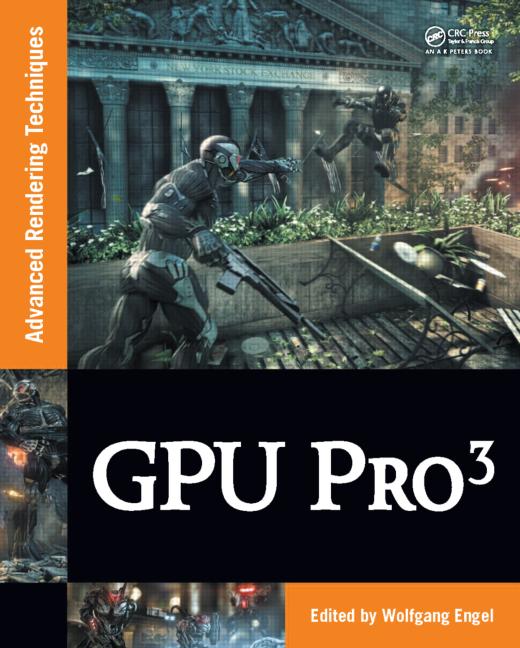
- Geometry Manipulation (Wolfgang Engel)
- Vertex Shader Tesselatin by Holger Gruen
- Real-time Deformable Terrain Rendering by Egor Yusov
- Optimized Stadium Crowd Rendering by Alan Chambers
- Geometric Anti-Aliasing Methods by Emil Persson
- Rendering (Christopher Oat)
- Practical Elliptical Texture Filtering by Pavlos Mavridis and Georgios Papaioannou
- An Approximation to the Chapman Grazing-Incidence Function for Atmospheric Scattering by Christian Schüler
- Volumetric Real-Time Water and Foam Rendering by Daniel Scherzer, Florian Bagar and Oliver Mattausch
- CryENGINE 3 by Tiago Sousa, Nick Kasyan, and Nicolas Schulz
- Inexpensive Anti-Aliasing of Simple Objects by Mikkel Gjol and Mark Gjol
- Global Illumination Effects (Carsten Dachsbacher)
- Ray-traced Approximate Reflections Using a Grid of Oriented Splats by Holger Gruen
- Screen-space Bent Cones: A Practical Approach by Oliver Klehm, Tobias Ritschel, Elmar Eisemann, Hans-Peter Seidel
- Real-time Near-field Global Illumination based on a Voxel Model by Sinje Thiedemann, Niklas Henrich, Thorsten Grosch, Stefan Mueller
- Shadows (Wolfgang Engel)
- Efficient Online Visibility for Shadow Maps by Oliver Mattausch, Jiri Bittner, Ari Silvnennoinen, Daniel Scherzer and Michael Wimmer
- Depth Rejected Gobo Shadows by John White
- 3D Engine Design (Wessam Bahnassi)
- Z3 Culling by Pascal Gautron, Jean-Eudes Marvie and Gaël Sourimant
- Quaternion-based rendering pipeline by Dzmitry Malyshau
- Implementing a Directionally Adaptive Edge AA Filter using DirectX 11 by Matthew Johnson
- Designing a Data-Driven Renderer by Donal Revie
- GPGPU (Sebastien St-Laurent)
- Volumetric transparency with Per-Pixel Fragment Lists” by Laszlo Szecsi, Pal Barta and Balazs Kovacs
- Practical Binary Surface and Solid Voxelization with Direct3D 11 by Michael Schwarz
- Interactive Ray Tracing Using the Compute Shader in DirectX 11 by Arturo Garca, Francisco Avila, Sergio Murgua and Leo Reyes
GPU Pro 4 (2013)

- Geometry Manipulation (Wolfgang Engel)
- GPU Terrain Subdivision and Tessellation by Benjamin Mistal
- Introducing the Programmable Vertex Pulling Rendering Pipeline by Christophe Riccio and Sean Lilley
- A WebGL Globe Rendering Pipeline by Patrick Cozzi and Daniel Bagnell
- Rendering (Christopher Oat and Carsten Dachsbacher)
- Practical Planar Reflections using Cubemaps and Image Proxies by Sébastien Lagarde and Antoine Zanuttini
- Real-Time Ptex and Vector Displacement by Karl Hillesland
- Decoupled Deferred Shading on the GPU by Gábor Liktor and Carsten Dachsbacher
- Tiled Forward Shading by Markus Billeter, Ola Olsson, and Ulf Assarsson
- Forward+: A Step Toward Film-Style Shading in Real Time by Takahiro Harada, Jay McKee, and Jason C. Yang
- Progressive Screen-Space Multi-Channel Surface Voxelization by Athanasios Gaitatzes and Georgios Papaioannou
- Rasterized Voxel-Based Dynamic Global Illumination by Hawar Doghramachi
- Image Space (Michal Valient)
- The `Skylands’ Depth-of-Field Shader by Michael Bukowski, Padraic Hennessy, Brian Osman, and Morgan McGuire
- Simulating Partial Occlusion in Post-Processing Depth-of-Field Methods by David C. Schedl and Michael Wimmer
- Second-Depth Anti-Aliasing by Emil Persson
- Practical Frame Buffer Compression by Pavlos Mavridis and Georgios Papaioannou
- Coherence-Enhancing Filtering on the GPU by Jan Eric Kyprianidis and Henry Kang
- Shadows (Wolfgang Engel)
- Real-Time Deep Shadow Maps by René Fürst, Oliver Mattausch, and Daniel Scherzer
- Game Engine Design (Wessam Bahnassi, editor)
- An Aspect-Based Engine Architecture by Donald Review
- Kinect Programming with Direct3D 11 by Jason Zink
- A Pipeline for Authored Structural Damage by Homam Bahnassi and Wessam Bahnassi
- GPGPU (Sebastien St-Laurent)
- Bit-Trail Traversal for Stackless LBVH on DirectCompute by Sergio Murguía, Francisco Ávila, Leo Reyes, and Arturo García
- Real-Time JPEG Compression using DirectCompute by Stefan Petersson
GPU Pro 5 (2014)
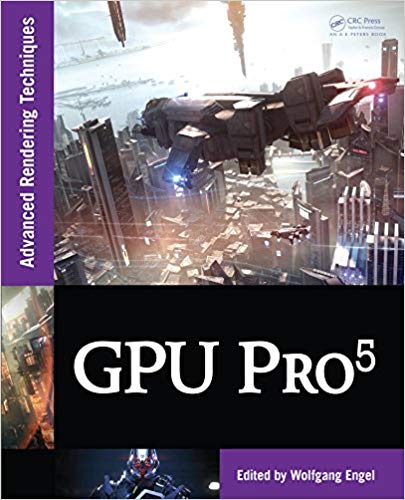
- Rendering (Carsten Dachsbacher)
- Per-pixel lists for Single Pass A-Buffer by Sylvain Lefebvre, Samuel Hornus and Anass Lasram
- Reducing Texture Memory Usage by 2-Channel Color Encoding by Krzysztof Kluczek
- GPU-accelerated Interactive Material Aging by Tobias Günther, Kai Rohmer, and Thorsten Grosch
- Simple Rasterization-Based Liquids by Martin Guay
- Lighting (Michal Valient)
- Physically Based Area Lights by Michal Drobot
- High Performance Outdoor Light Scattering using Epipolar Sampling by Egor Yusov
- Volumetric Light Effects in Killzone Shadow Fall by Nathan Vos
- Hi-Z Screen-Space Cone-Traced Reflections by Yasin Uludag
- TressFX – Advanced Real-Time Hair Rendering by Timothy Martin, Wolfgang Engel, Nicolas Thibieroz, Jason Yang and Jason Lacroix
- Wire Anti-Aliasing by Emil Persson
- Image Space (Christopher Oat)
- Screen Space Grass by David Pangerl
- Screen Space Deformable Meshes via CSG with Per-Pixel Linked Lists by João Raza and Gustavo Nunes
- Bokeh Effects on the SPU by Serge Bernier
- Mobile Devices (Marius Bjørge)
- Realistic Real-Time Skin Rendering on Mobile by Renaldas Zioma and Ole Ciliox
- Deferred Rendering Techniques on Mobile Devices by Ashley Vaughan Smith
- Bandwidth Efficient Graphics with ARM Mali GPUs by Marius Bjørge
- Efficient Morph Target Animation using OpenGL ES 3.0 by James Lewis Jones
- Tiled Deferred Blending by Ramses Ladlani
- Adaptive Scalable Texture Compression by Stacy Smith
- Optimising OpenCL kernels for the ARM Mali-T600 GPUs by Johan Gronqvist and Anton Lokhmotov
- 3D Engine Design (Wessam Bahnassi)
- Quaternions Revisited by Peter Sikachev, Vladimir Egorov and Sergey Makeev
- glTF: Designing an Open-Standard Runtime Asset Format by Fabrice Robinet, Rémi Arnaud, Tony Parisi, and Patrick Cozzi
- Managing Transformations in Hierarchy by Bartosz Chodorowski and Wojciech Sterna
- Compute (Wolfgang Engel)
- Hair Simulation in TressFX by Dongsoo Han
- Object-Order Ray Tracing for Fully Dynamic Scenes by Tobias Zirr, Hauke Rehfeld and Carsten Dachsbacher
- Quadtrees on the GPU by Jonathan Dupuy, Jean-Claude Iehl, and Pierre Poulin
- Two-level Constraint Solver by Takahiro Harada
- Non-Separable 2D, 3D and 4D Filtering with Cuda by Anders Eklund and Paul Dufort
GPU Pro 6 (2015)

- Geometry (Wolfgang Engel)
- Dynamic GPU Terrain by David Pangerl
- Bandwidth Efficient Procedural Meshes in the GPU via Tessellation by Gustavo Bastos Nunes and João Lucas Guberman Raza
- Real-Time Deformation of Subdivision Surfaces on Object Collisions by Henry Schaefer, Matthias Nießner, Benjamin Keinert and Marc Stamminger
- Realistic Volumetric Explosions in Games by Alex Dunn
- Rendering (Christopher Oat)
- Next-Gen Rendering in Thief by Peter Sikachev, Samuel Delmont, Uriel Doyon, and Jean-Normand Bucci
- Grass rendering and simulation with LOD by Dongsoo Han and Hongwei Li
- Hybrid Reconstruction Anti-aliasing by Michał Drobot
- Real-time Rendering of Physically-Based Clouds using Pre-computed Scattering by Egor Yusov
- Sparse Procedural Volume Rendering by Doug McNabb
- Lighting (Michal Valient)
- Real-time lighting via Light Linked List by Abdul Bezrati
- Deferred normalized irradiance probes by John Huelin, Benjamin Rouveyrol and Bartłomiej Wroński
- Volumetric fog and lighting by Bartłomiej Wroński
- Physically Based Light Probe Generation On GPU by Ivan Spogreev
- Real-time global illumination using slices by Hugh Malan
- Shadows (Wolfgang Engel)
- Practical Screen-Space Soft Shadows” by Márton Tamás and Viktor Heisenberger
- Tile-Based Omnidirectional Shadows by Hawar Doghramachi
- Shadow Map Silhouette Revectorization by Vladimir Bondarev
- Mobile Devices (Marco Bjørge)
- Hybrid Ray Tracing on a PowerVR GPU by Gareth Morgan
- Implementing a GPU-only particles collision system with ASTC 3D textures and OpenGL ES 3.0 by Daniele Di Donato
- Animated Characters with Shell Fur for Mobile Devices by Andrew Girdler and James L Jones
- High Dynamic Range Computational Photography on mobile GPUs by Simon McIntosh-Smith, Amir Chohan, Dan Curran and Anton Lokhmotov
- Compute (Carsten Dachsbacher)
- Compute-Based Tiled Culling by Jason Stewart
- Rendering Vector Displacement Mapped Surfaces in a GPU Ray Tracer by Takahiro Harada
- Smooth Probabilistic Ambient Occlusion for Volume Rendering by Thomas Kroes, Dirk Schut and Elmar Eisemann
- 3D Engine Design (Wessam Bahnassi)
- Blockwise Linear Binary Grids for Fast Ray Casting Operations by Holger Gruen
- Semantic based shader generation using Shader Shaker by Michael Delva, Julien Hamaide and Ramses Ladlani
- ANGLE: Bringing OpenGL ES to the Desktop by Shannon Woods, Nicolas Capens, Jamie Madill and Geo Lang
GPU Pro 7 (2016)
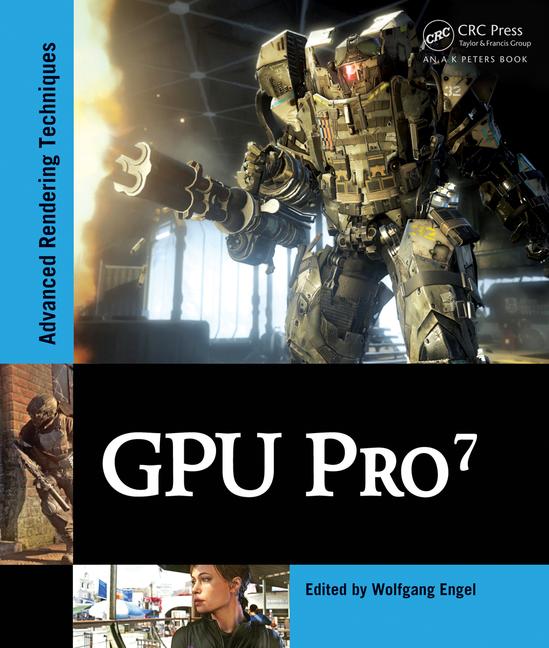
- Geometry Manipulation (Carsten Dachsbacher)
- Hardware-Tessellated Deformable Snow in Rise of the Tomb Raider by Anton Kai Michels and Peter Sikachev
- Catmull Clark Subdivision Surfaces by Wade Brainerd
- Lighting (Michal Valient)
- Clustered shading: Assigning lights using conservative rasterization in DirectX12 by Kevin Örtegren and Emil Persson
- Fine Pruned Tiled Light Lists by Morten S. Mikkelsen
- Deferred Attribute Interpolation Shading by Christoph Schied and Carsten Dachsbacher
- Real-time volumetric cloudscapes by Andrew Schneider
- Rendering (Christopher Oat)
- Adaptive Virtual Textures by Ka Chen
- Deferred Coarse Pixel Shading by Rahul P. Sathe and Tomasz Janczak
- Progressive Rendering using Multi-Frame Sampling by Daniel Limberger, Karsten Tausche, Johannes Linke, and Jürgen Döllner
- Mobile Devices (Marius Bjorge)
- Efficient Soft Shadows Based on Static Local Cube map by Sylvester Bala, Roberto Lopez Mendez
- 3D Engine Design (Wessam Bahnassi)
- Interactive Cinematic Particlesby Homan and Wessam Bahnassi
- Real-time BC6H compression on GPU by Krzysztof Narkowicz
- A 3D Visualization Tool used for Test Automation in the Forza Series by Gustavo Bastos Nunes
- Semi-Static Load Balancing for Low Latency Ray Tracing on Heterogeneous Multiple GPUs by Takahiro Harada
- Compute (Wolfgang Engel)
- Octree Mapping from a Depth Camera by Dave Kotfis and Patrick Cozzi
- Interactive Sparse Eulerian Fluid by Alex Dunn
GPU Zen 1 (2017)
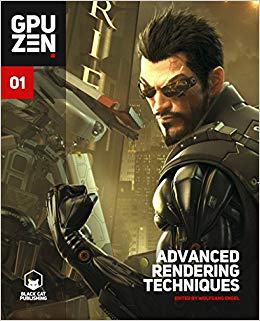
- Geometry Manipulation (Christopher Oat)
- Attributed Vertex Clouds by Willy Scheibel, Stefan Buschmann, Matthias Trapp, and Jürgen Döllner
- Rendering Convex Occluders with Inner Conservative Rasterization by Marcus Svensson and Emil Persson
- Lighting (Carsten Dachsbacher)
- Rendering stable indirect illumination computed from reflective shadow maps by Louis Bavoil and Holger Gruen
- Real-Time Participating Media Effects Using Extruded Light Volumes by Nathan Hoobler, Andrei Tatarinov and Alex Dunn
- Rendering (Mark Chatfield)
- Deferred+: Next-Gen Culling and Rendering for Dawn Engine by Hawar Doghramachi and Jean-Normand Bucci
- Programmable per-pixel sample placement with conservative rasterizer by Rahul P. Sathe
- Mobile Toon Shading by Felipe Lira, Flavio Villalva, Jesus Sosa, Kleverson Paix~ao and Teofilo Dutra
- High Quality GPU-efficient Image Detail Manipulation by Kin-Ming Wong and Tien-Tsin Wong
- Real-Time Linear-Light Shading with Linearly Transformed Cosines by Eric Heitz and Stephen Hill
- Profiling and Optimizing WebGL Application Using Google Chrome by Gareth Morgan
- Screen-Space (Wessam Bahnassi)
- Scalable Adaptive SSAO by Filip Strugar
- Robust Screen Space Ambient Occlusion in 1 ms at 1080p on PS4 by Wojciech Sterna
- Practical Gather-based Bokeh Depth of Field by Wojciech Sterna
- Virtual Reality (Eric Haines)
- Efficient Stereo and VR Rendering by Iñigo Quilez
- Understanding, Measuring, and Analyzing VR Graphics Performance by James Hughes, Reza Nourai, and Ed Hutchins
- Compute (Wolfgang Engel)
- Optimizing the Graphics Pipeline with Compute by Graham Wihlidal
- Real Time Markov Decision Processes for Crowd Simulation by Sergio Ruiz and Benjamin Hernandez
GPU Zen 2 (2019)

- Rendering (Patrick Cozzi)
- Adaptive GPU Tessellation with Compute Shaders by Jad Khoury, Jonathan Dupuy, and Christophe Riccio
- Applying Vectorized Visibility on All frequency Direct Illumination by Ho Chun Leung, Tze Yui Ho, Zhenni Wang, Chi Sing Leung, Eric Wing Ming Wong
- Non-periodic Tiling of Noise-based Procedural Textures by Aleksandr Kirillov
- Rendering Surgery Simulation with Vulkan by Nicholas Milef, Di Qi, and Suvranu De
- Skinned Decals by Hawar Doghramachi
- Environmental Effects (Wolfgang Engel)
- Real-Time Fluid Simulation in Shadow of the Tomb Raider by Peter Sikachev, Martin Palko and Alexandre Chekroun
- Real-time Snow Deformation in Horizon Zero Dawn: The Frozen Wilds by Kevin Örtegren
- Shadows (Mauricio Vives)
- Soft Shadow Approximation for Dappled Light Sources by Mariano Merchante
- Parallax-Corrected Cached Shadow Maps by Pavlo Turchyn
- 3D Engine Design (Wessam Bahnassi)
- Real-Time Layered Materials Compositing Using Spatial Clustering Encoding by Sergey Makeev
- Procedural Stochastic Textures by Tiling and Blending by Thomas Deliot and Eric Heitz
- A Ray Casting Technique for Baked Texture Generation by Alain Galvan and Jeff Russell
- Writing an efficient Vulkan renderer by Arseny Kapoulkine
- glTF – Runtime 3D Asset Delivery by Marco Hutter
- Ray Tracing (Anton Kaplanyan)
- Real-Time Ray-Traced One-Bounce Caustics by Holger Gruen
- Adaptive Anti-Aliasing using Conservative Rasterization and GPU Ray Tracing by Rahul Sathe, Holger Gruen, Adam Marrs, Josef Spjut, Morgan McGuire, Yury Uralsky

